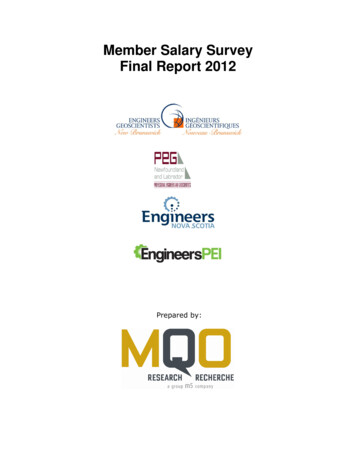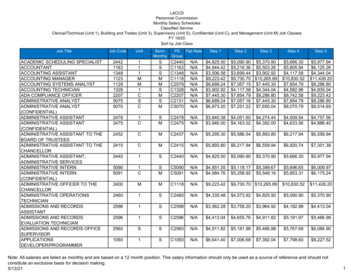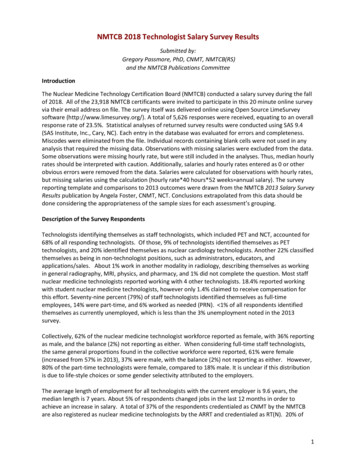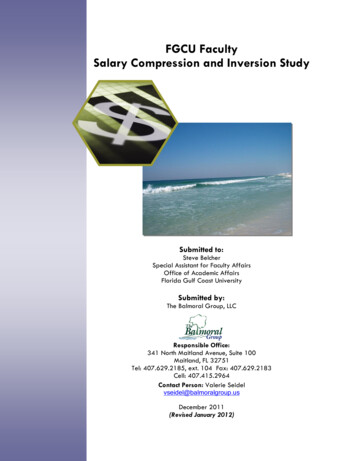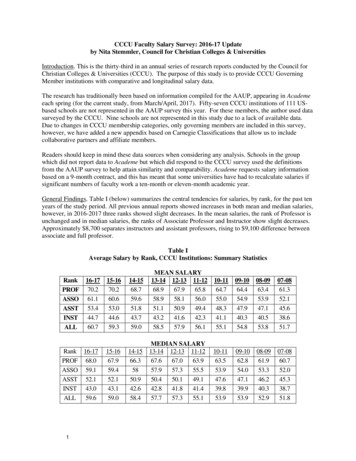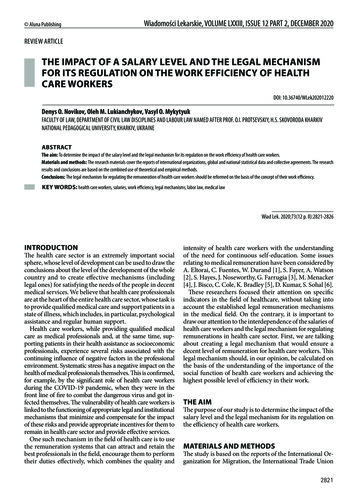
Transcription
Aluna PublishingWiadomości Lekarskie, VOLUME LXXIII, ISSUE 12 PART 2, DECEMBER 2020REVIEW ARTICLETHE IMPACT OF A SALARY LEVEL AND THE LEGAL MECHANISMFOR ITS REGULATION ON THE WORK EFFICIENCY OF HEALTHCARE WORKERSDOI: 10.36740/WLek202012220Denys O. Novikov, Oleh M. Lukianchykov, Vasyl O. MykytyukFACULTY OF LAW, DEPARTMENT OF CIVIL LAW DISCIPLINES AND LABOUR LAW NAMED AFTER PROF. O.I. PROTSEVSKIY, H.S. SKOVORODA KHARKIVNATIONAL PEDAGOGICAL UNIVERSITY, KHARKIV, UKRAINEABSTRACTThe aim: To determine the impact of the salary level and the legal mechanism for its regulation on the work efficiency of health care workers.Materials and methods: The research materials cover the reports of international organizations, global and national statistical data and collective agreements. The researchresults and conclusions are based on the combined use of theoretical and empirical methods.Conclusions: The legal mechanism for regulating the remuneration of health care workers should be reformed on the basis of the concept of their work efficiency.KEY WORDS: health care workers, salaries, work efficiency, legal mechanisms, labor law, medical lawWiad Lek. 2020;73(12 p. II):2821-2826INTRODUCTIONThe health care sector is an extremely important socialsphere, whose level of development can be used to draw theconclusions about the level of the development of the wholecountry and to create effective mechanisms (includinglegal ones) for satisfying the needs of the people in decentmedical services. We believe that health care professionalsare at the heart of the entire health care sector, whose task isto provide qualified medical care and support patients in astate of illness, which includes, in particular, psychologicalassistance and regular human support.Health care workers, while providing qualified medicalcare as medical professionals and, at the same time, supporting patients in their health assistance as socioeconomicprofessionals, experience several risks associated with thecontinuing influence of negative factors in the professionalenvironment. Systematic stress has a negative impact on thehealth of medical professionals themselves. This is confirmed,for example, by the significant role of health care workersduring the COVID-19 pandemic, when they were in thefront line of fire to combat the dangerous virus and got infected themselves. The vulnerability of health care workers islinked to the functioning of appropriate legal and institutionalmechanisms that minimize and compensate for the impactof these risks and provide appropriate incentives for them toremain in health care sector and provide effective services.One such mechanism in the field of health care is to usethe remuneration systems that can attract and retain thebest professionals in the field, encourage them to performtheir duties effectively, which combines the quality andintensity of health care workers with the understandingof the need for continuous self-education. Some issuesrelating to medical remuneration have been considered byA. Eltorai, C. Fuentes, W. Durand [1], S. Fayer, A. Watson[2], S. Hayes, J. Noseworthy, G. Farrugia [3], M. Menacker[4], J. Bisco, C. Cole, K. Bradley [5], D. Kumar, S. Sohal [6].These researchers focused their attention on specificindicators in the field of healthcare, without taking intoaccount the established legal remuneration mechanismsin the medical field. On the contrary, it is important todraw our attention to the interdependence of the salaries ofhealth care workers and the legal mechanism for regulatingremunerations in health care sector. First, we are talkingabout creating a legal mechanism that would ensure adecent level of remuneration for health care workers. Thislegal mechanism should, in our opinion, be calculated onthe basis of the understanding of the importance of thesocial function of health care workers and achieving thehighest possible level of efficiency in their work.THE AIMThe purpose of our study is to determine the impact of thesalary level and the legal mechanism for its regulation onthe efficiency of health care workers.MATERIALS AND METHODSThe study is based on the reports of the International Organization for Migration, the International Trade Union2821
Denys O. Novikov et al.Fig. 1. The ratio of the average salary in the state and the average salary in the field of health care and social work activities, 2005-2020, Ukraine (EUR).Source: Data from State service of the statistics of UkraineTable 1. Number of health care workers in Ukraine and regions. Source: Data from State service of the statistics of UkraineUkraineKharkiv RegionVinnytsia RegionZakarpattiaNumber of Health care workers (Ukraine, regions)Number of doctors of all specialtiesNumber of nursing stafftotal, thousandper 10 000 personstotal, thousandper 10 000 35,412,98,8104,170,55Confederation, statistics collected by Eurostat, the Ministry of Health of Ukraine, the State Service of Statistics ofUkraine and its regional branches, the State Statistical Service of the Republic of Poland. The study material includedregulations, jurisprudence of national courts of Ukraine,collective agreements of Kharkiv hospitals.The statistical indicators used in the study reflect the databetween 2005 and 2020. The relationship between the levelof salaries and the legal mechanism of their regulation to theeffectiveness of health care workers was examined on the basisof indicators of salary dynamics and the amount of the serviceand standardization of work established by the regulatory acts.The research results and conclusions are based on thecombined application of theoretical and empirical methods. Among the theoretical methods, the comparative,normative-logical and prognostic methods have beenused. The empirical methods have been used in the studyfor processing the statistics, comparing and summarizing.REVIEW AND DISCUSSIONThe study of the level of health care workers remunerationcovers the period from 2005 to 2020. We found out that thedynamics of the salaries of health care workers for the selected2822period has positive growth indicators (except for the periodfrom 2014 to 2018). In relation to the average salary in the state,the salaries of health care workers traditionally remain lower,despite the medical reform.According to the State Statistics Service of Ukraine, since thesecond quarter of 2020, the average monthly salary of full-timehealth care workers has been 7,720 UAH (259 ), which is 70.7%of the average salary in the country – 10,928 UAH (366 ). Interms of the average monthly salary, this area has the 23rd rankout of 26 [7].As we can see, the efficiency of health care workers dependsnot only on the amount of the salary, but also on the workload of such an employee and on the interdependence and theratio of the salary to the work load. That's why we are turningto the study of the dynamics of the work load, which is bestdemonstrated by the dynamics of changes in the number ofhealth care workers.According to the reference book “Medical Personnel and theNetwork of Health care Institutions of the Ministry of Healthof Ukraine for 2018-2019”, prepared by the workers of theState Institution “Center for Medical Statistics of the Ministryof Health of Ukraine” in 2019, there are 18,797,275 full-timemedical positions in Ukraine 16,328,175 – occupied medicalpositions, and the number of individual physicians is 154,265
THE IMPACT OF A SALARY LEVEL AND THE LEGAL MECHANISM FOR ITS REGULATION ON THE WORK EFFICIENCY.Fig. 2. Number of physicians per 10,000 persons. Source: Data from EurostatFig. 3. Number of physicians per 10,000 persons and the average length of stay in treatment. Source: Data from Eurostat.[8]. For the correct analysis, we should point out that the aboveindicators (Table 1) show the number of full-time medicalpositions, but not the number of doctors.Our figures show that during the selected period there wasa reduction in the number of physicians and the nursing staffin both absolute and relative numbers. The relative numberof physicians (per 10,000 persons) in Ukraine decreased by5.97% and the number of the nursing staff – by 25.13%. Therewas a 25.13% increase in the workload of the nursing staff,which may lead to an increase in the workload of doctors,who, with a shortage of the necessary number of nurses, willhave to perform their duties as well. The dynamics of changesin the number of physicians is uneven through the regions: adecrease in Kharkiv Region – by 6.36%, in Zakarpattia – by15.91%, but in Vinnytsia there is an increase of 2.66%. Thedynamics of changes in the number of average medical staffis less polarized. The attention should also be paid to the difference in the dynamics of reduction in the relative number ofphysicians (5.97%) and the nursing staff (25.13%). At the sametime, according to the Eurostat report, the number of physiciansper 10,000 inhabitants in the European Union varies between18.6 (in Turkey) and 60.6 (in Greece), with an average of 36.4.Between 2012 and 2017, the number of physicians increasedin all EU countries (9).At the same time, we can observe the following situation inUkraine: the amount of work, calculated for 187,972 full-timehealth care workers, is actually performed by 154,265 healthcare workers. The real availability of physicians in Ukraine is2823
Denys O. Novikov et al.Fig. 4. Average salary in Poland and Ukraine in health care (EUR). Source: Data from Rocznik Statystyczny Pracy and State service of the statistics of Ukraine36.96 per 10,000 persons and there are 270 patients per a physician (222 patients per a doctor are planned for the numberof full-time positions). Thus, the physician's workload is 21.6%more than planned. According to the regional indicators (Table1), the workload of physicians in Kharkiv Region is 48.3% higher than in Zakarpattia (in 2005 that difference was 33.2%). Atthe same time, the average monthly salary in the field of healthcare in Kharkiv Region as of June 2020 is only 12.7% higher [10].We believe that the imperfect regulation of the remunerationof health care workers poses a significant risk of their migrationto the European Union, particularly to Poland.If to compare the dynamics of migration from Ukraine wecan see that in the peak years of the reduction in the number ofhealthcare workers, there were the highest rates of migration.According to the report of the International Organizationfor Migration, from 2008 to 2018 the number of first issuedresidence permits for Ukrainian citizens in the EU countriesincreased almost 5 times [11]. During this period Poland became the main destination country for the labor migrants fromUkraine (their number increased five times) [11]. One of theindustries that attracted Ukrainian citizens was the health caresector. In 2018, the average salary in the health care sector inPoland was 1,015.2 EUR, which is 96.2% of the average salaryin the country – 1,055.6 EUR. In terms of the average monthlysalary, this sector ranks 10 out of 18 [12].The number of physicians per 10, 000 inhabitants is 23.7 inPoland and 36.96 in Ukraine respectively. The doctor's workload in Poland is 55% higher than in Ukraine, and the salary is425% higher. The number of physicians in Poland is increasing[9], the workload of physicians is decreasing, while in Ukrainethe opposite trend is observed. At the same time, in 2019, thedeficit of medical staff in established positions of doctors was12% and the deficit of nurses was 7% [13].In order to understand the prerequisites of the considerednegative trends in the remuneration of health care workers,we will turn to the analysis of the current system of the remuneration of health care workers in Ukraine. It should be noted2824that the current system of payment for health care workers wasformed in 2005. Since then, the payment for health care workershas been regulated by the Order of the Ministry of Labor andSocial Policy of Ukraine, the Ministry of Health of Ukraine 308/519, which approved the “The terms of the regulation oflabor remuneration of health care facilities and institutions ofsocial protection”.The remuneration system does not provide an automaticincrease in the physician's salary in connection with the increase in the number of patients. Instead of that, it providessome additional payments for the expansion of the servicearea or an increase in the scope of work, which is up to 50 percent of an employee's official salary. These extra payments areset for the workers if they are working with a smaller numberof workers than the established standards require. The statedoes not establish the criteria for the dependency of the extrapayments on the expansion of the scope of services.In our opinion, in this aspect the system of calculating salaries of workers did not meet the requirements of the Law “OnRemuneration of Labor” for years and was much smaller. Thisfact was recognized by the state only in 2016, when the currentapproach to calculating salaries was declared to be illegal. Thatis why it cannot be considered that such a surcharge reallycompensated for the increase in the workload [14; 15]. In thecurrent tariff system of remuneration of health care workers,the salaries (tariff rates) from January 1, 2017 are calculatedbased on the salary (tariff rate) of the employee of the 1st tariffcategory, set at the subsistence level for able-bodied persons onJanuary,1 of the calendar year. However, it cannot be consideredto be fair, as the state itself recognizes that the subsistence levelis not the subsistence level [16].As a result of the medical reform in Ukraine, the system ofremuneration of health care workers has not changed. Fundsthat can increase the salaries are transferred to hospitals. Thelegislator and the Ministry of Health of Ukraine have not established new criteria for calculating salaries in the frameworkof medical reform. In this situation, there are two parts of the
THE IMPACT OF A SALARY LEVEL AND THE LEGAL MECHANISM FOR ITS REGULATION ON THE WORK EFFICIENCY.salaries of health care workers, which are already included inthe reform: one is mandatory, regulated by “The terms of theregulation of labor remuneration of health care facilities andinstitutions of social protection”, and the second – variable(bonus) – regulated by a collective agreement, the regulationon bonuses and the order of the chief physician.The specific amount of the premium is set monthly by theorder of the chief medical officer of the health care institution“taking into account the personal contribution of the employeeto the overall result of the work”. The regulation of the remuneration by the order of the chief medical officer leads to thesituation where the amount of the bonus has been set at 12%,15%, and 25% of the amount of the funding of the declarationsmade with the doctor on the same basis positions in varioushospitals. Then the situation is as follows: the basic salary is 2.5times less than the “bonus”. For example, a family doctor of thehighest category has 14 tariff classes and the tariff coefficient2.42 is used to calculate the salary. The tariff rate for such a doctor is 5,086 UAH (156 EUR) and the monthly bonus is 12,734UAH (391 EUR). So, we can state that the variable part of thesalary, which is regulated by the acts of the social dialogue andthe order of the chief medical officer, is the main one. However,the powers of the chief medical officer to determine the amountof the bonus are limited by the possibility of influencing thestaff of the health care institution on the size of the latter byconcluding a collective agreement. However, according to theGlobal Index of Workers' Rights, compiled by the InternationalConfederation of Trade Unions, due to the almost completeabsence of independent unions, Ukraine has a rating of 5 (worst- 5 ) [17]. Therefore, it is questionable whether to use socialdialogue to effectively regulate the remuneration of health careworkers in Ukraine.On this basis, as part of the medical reform, there is a situation of unjustified differentiation of salaries at the expense ofbonuses. Health care workers who are out of the reform receivea fixed salary that is linked to the labor standards, and a bonus isawarded only as an additional remuneration (optional). Healthcare workers in the reform area also receive a fixed basic salary,but in addition they receive a bonus (obligatory), the amountof which depends on the will of the chief medical officer butnot on the work efficiency.In our opinion, in order to improve the situation with thesalaries in the health care sector in Ukraine, it is necessaryto reform the medical sector based on the efficiency of workand create appropriate legal support. After all, in today'senvironment, if health care workers simply receive highersalaries than a competitive market, it will involve containingcosts in this sector while maintaining the current quality level[18]. Health care workers often report that low salaries are abarrier to efficiency, but there is little evidence that the highersalaries actually bring better results. Therefore, the benefit ofthe efficiency-based salary is that it aligns the bonuses and remuneration of health care workers with the specific goals of thedistrict or the facility, where the health care workers employed.This motivates health workers to pursue their goals in orderto receive additional compensation for achieving the goals.We must emphasize that it is important to differentiatebetween the salaries based on the concept of efficiency andeffectiveness, i.e. based on concluding contracts with a certain number of potential patients (in Ukraine – declarations)and cured patients. In the latter case, the heads of health careinstitutions usually have a very high degree of freedom inrecruiting workers and paying compensation (bonuses) fortheir results achieved. There are numerous potential gaps inperformance-based remuneration: the risk of unnecessary care;the risk of increasing medical care costs; and bonuses based onthe improved productivity or quality of care, regardless of whois receiving the help and who really needs it.We believe that the main impulse for efficiency-oriented remuneration is to increase the efficiency of health care workers(e.g., work efficiency, service quality) in order to improve thequality of medical care and, finally, the health status of citizens. For this purpose, it is necessary: 1) to transfer the rightto hire health workers to non-governmental organizations onfixed-term contracts for a maximum of five years; 2) to givenon-governmental organizations the right to monitor the salaries of health workers throughout the country and regions; 3)to establish a certain number of claims made to patients withterritorially differentiated and resolute medical treatment; 4) toset the minimum salary of a health care employee at the levelof the average salary in the country; 5) to combine individual(pay on the basis of the performance of the doctor in particularissue) and collective tools to stimulate effective work (premiums depending on the size of the services, labor intensity,etc.). Individual incentives are allowed by non-governmentalorganizations and collective incentives by health care providers.This legal mechanism must be carefully designed. For example, their implementation in the practice of health care workersin Cambodia has shown that the incentives focused on laborproductivity were too low to have a significant impact on healthcare workers' activities. In Romania, incentives to encouragedoctors to work in rural areas did not work because they weretoo small and illegal. Poorly designed incentives can lead tosocially undesirable results. In China, the bonuses aimed atimproving doctors' efficiency have increased the provisionof unnecessary services and medicines and in
a reduction in the number of physicians and the nursing staff in both absolute and relative numbers. The relative number of physicians (per 10,000 persons) in Ukraine decreased by 5.97% and the number of the nursing staff – by 25.13%. There wa





